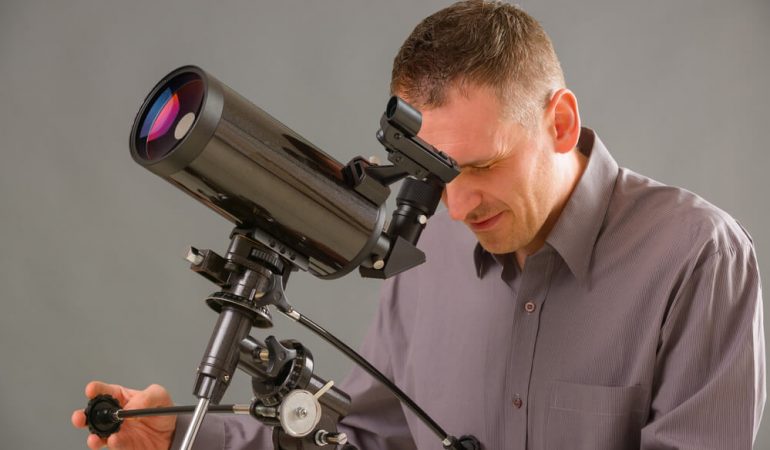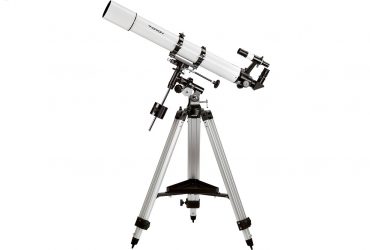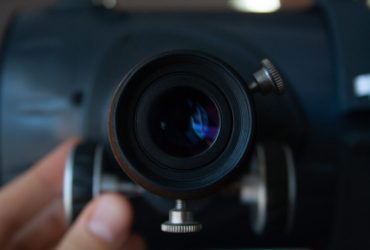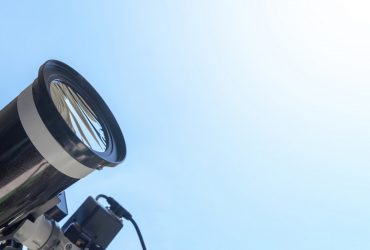A Guide To The Best Reflector Telescopes On The UK Market
Like everyone else on earth, you’ve probably stared up into the heavens and asked yourself the all important question – “Are we alone?” Well, you’re not alone; at least in regards to stargazing, not extra terrestrial life (as far as we know).
See, every single day and night, thousands of eager, beginner astronomers grab whatever equipment they can to get a better look at the large expanse of space. Despite the fact that our Milky Way is nothing but a mere blip on the cosmic scale, there are billions of stars to check out.
So if you want to turn from curious wonderment to learned space explorer, you’ll need a telescope built for the job – The classic reflector.
i) Looking for the only reflector telescope you’ll ever need? Aptly dubbed as the most well rounded, overall reflector on the list, the Skywatcher Explorer Motorised Reflector balances price and performance perfectly.
ii) Fact – every potential astronomer has to start somewhere. But once you grow tired of your cheap, first telescope, you know it’s time to upgrade. By coughing up just a little more green, you’ll be able to afford the best upgrade reflector telescope in the market – the Skywatcher Explorer 200PDS OTA Newton Telescope.
iii) Here’s a steal no matter which way you look at it. In addition to being the cheapest telescope on our list, this budget telescope is ironically the only one that offers unrivalled images of both terrestrial and astronomical bodies. We’re talking about the number one choice for young astronomers, the AstroMaster 114 EQuatorial Telescope from Celestron.
Reflector Telescope Buying Guide
What is a Reflector Telescope?
Also referred to as a reflecting telescope, the reflector was invented back in the 17th century by Isaac Newton. As the name implies, these types of scopes reflect light to form an image through a combination of curved mirrors. A reflector telescope makes use of bigger concave mirrors as opposed to the usual lenses found in other types to collect and focus light.
The two main reasons why a reflector telescope is perfect for beginners is due to the good visibility and affordable price range. Also, it’s every stargazers wet dream so to speak. See, reflectors excel at celestial gazing. This means you’ll be getting breathtaking views of moons, stars, galaxies, nebulae and other faint, distant objects. Oh, and word to the wise, try not to use your reflector telescope during the day. So, how do you make sure you get the best telescope for the job?
Key Considerations for Buying a Reflector
i) Do you Know What you Want the Scope For?
It might seem like a basic question, but you’d be surprised just how many beginner astronomers get it wrong. Speaking from experience, most first time buyers want a telescope that will provide great views of both land and outer space objects.
But as good as the though of an all round telescope may be, the sad truth is that most of them only excel at either one or the other, not both. With the reflector telescope, you can forget about looking at any land based objects since it excels at astronomy viewing.
ii) Consider the Aperture
Now that you know you’re only limited to astronomical objects, the most important feature to consider next is the aperture. This refers to the diameter of the main mirror in the telescope. The larger the aperture, the more light you can capture and the more objects you can locate in the sky. More light also translates to greater clarity and spectacular views.
iii) Consider the Magnification
This is not really a decisive factor, but more of a vital concept that will help beginners understand their reflectors better. Some expert astronomers claim that the magnification is just as important as the aperture. In theory, your telescope should be able to achieve an infinite range of magnification just by swapping out the eyepiece for one with a higher magnification. Just make sure that your aperture produces a clear image before magnifying it to extremely high levels.
Best Reflector Telescope Reviews
1. BEST OVERALL: Skywatcher Explorer Motorised Reflector
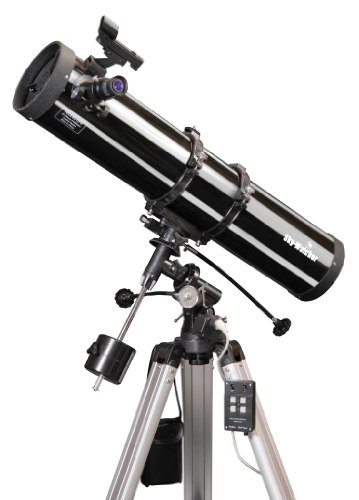
Pros
- Shows celestial objects in greater detail
- 30% more light gathering capabilities than 114mm
- Motorised, EQ2 Equatorial mount
Cons
- Assembling this model is a bit tedious
Overview
There’s no denying it, Newtonian telescopes offer some of the best views you’ll ever catch. Combine that with one of the leading scope manufacturers and you’ve got magic waiting to happen. The Skywatcher explorer range comprises of high quality, robust, versatile Newtonian reflectors that range in aperture.
Whether you want a light guzzling 300mm aperture or a respectable 130mm like the one we’re looking at here, Skywatcher’s got them all. This particular motorised reflector telescope from skywatch is hands down the best overall model on our list.
In addition to having the power, aperture and magnification to show celestial objects in greater detail, the EQ2 mount is actually motorised so you don’t have to do all the heavy lifting.
The Explorer also boasts of a x260 highest practical power and 0.5mm ultra thin secondary mirror supports. There’s also a red dot finder to help you centre the view and thanks to 30% more light gathering than 114mm, stargazing never looked so vivid.
What It Does Best
Looking at the Skywatcher Explorer Motorised Newtonian Reflector Telescope it’s clear that it excels in more than one area.
For starters, this particular telescope has one of the largest mirrors you can find in its price range. This is a massive advantage because it provides you with the ability to gather far more light than other scopes. Combine that with the fact that the collimation of mirrors are perfectly aligned and you have an image that would make even expert astronomers proud.
Secondly, the 130m Explorer incorporates a motor that allows you to silently track any target as it makes its way across the sky. This is very useful if you are observing something as a group or under high observation. It doesn’t even matter if there’s bad weather or cloud cover, the telescope still tracks away.
Flaws But Not Dealbreakers
As magnificent (pun intended) as the Skywatcher Explorer Newtonian Reflector Telescope might be, there are still a couple of issues that I noticed. The first minor issue was the slight distortion under high magnification. At over 85% of the view, this telescope tends to provide some slight distortion.
However, it’s only really close to the edges and barely noticeable. But that’s only if you actually manage to get the darn thing set up. The instructions are quite flimsy and very confusing. But it’s still easy enough for beginners to set up, at least after several tries.
What Other Customers Think
Being the best overall reflector telescope on this list, it’s only natural that everyone has good things to say about it. After all, it’s always a welcome sight to get a model that caters to the needs of astronomers of all levels.
Most customers found the Explorer to be a great option for beginners with a sturdy and well made stand. As always, the motorized function is tricky to master as most came to realize. But once you get it, it’s super easy to use. All in all, a great gift for the budding astronomer in your life.
Should You Buy It?
Whether you’re just starting out your astronomer journey or looking to upgrade from your cheap beginner’s scope, then the 130M Explorer is the choice for you. Not only is the price range relatively budget friendly, but the Newtonian telescope actually holds it’s own in the field of battle. It will give you a crystal clear view of celestial objects, and still allow you to track them even when you’re nowhere near the scope. That’s what I call modern and futuristic star gazing.
2. BEST UPGRADE: Skywatcher Explorer 200 PDS OTA Newton Telescope
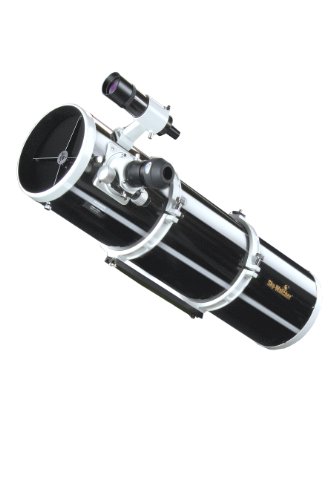
Pros
- Best quality to price ratio for the OTA and Mount
- Incredible focus quality with zero image shift
- Almost 80% more light capture
Cons
- The mount head is quite bulky and heavy due to cast aluminium construction
Overview
Here’s another reflector telescope that’s been making rounds all over the astronomer universe. Praised all over for its incredible stability and performance, the Skywatcher Explorer Telescope might just be the best upgrade option out there.
Hey, everyone had to start at some point. And like most beginners, your first scope was probably a cheap model. But if you’re ready to take the next step and upgrade to better, clearer and further views, then this is the next logical purchase.
The 200PDS Explorer boasts of a x36 magnification with ultra thin 0.5 mm brackets for the secondary mirror. And beating the previous model by a mile, the Skywatcher 200 PDS actually manages almost 80% more light capture than 150mm.
What It Does Best
The Skywatcher 200 PDS Newton Telescope excels at the one thing it was made to do; and that’s delivering crystal clear images free from distortion. See, instead of the usual lenses, reflectors usually come equipped with mirrors.
The high quality mirrors in this telescope help eliminate any spherical aberrations while still focusing all the light rays for sharper, more contrasted images that are rich in detail. Another area where the model excels is the incorporation of a dual speed 10:1 focuser that offers a uch fi8ner focus function than the previous model.
Flaws But Not Deabreakers
The Skywatcher 200PDS OTA scope may be a winner in many astronomer’s books, but I noticed a couple of issues that I’ll raise with the manufacturer. Of course, they are not deal breakers, just problems that would make the experience much smoother if resolved.
For instance, this telescope has a much shorter tube to go with the 1000mm focal length. This makes it more suited for astrophotography than visual observation. Still, it offers excellent observation, I just think it would be much better if the tube was a tad longer.
What Other Customers Think
Looking at previous customers, I couldn’t help but notice that majority of them were surprised by the size and weight of this model. The 200PDS Telescope is quite bulky and will definitely need a car to transport so don’t say you weren’t told.
But apart from the sheer bulk, all customers seem to have gleaming reviews for this bad boy. From the fact that it’s mirrors are perfectly aligned all the way to a 10:1 focuser, everyone seems satisfied and happy with the scope.
Should You Buy It?
The Explorer-200PDS OTA Dual-Speed is hands down one of the best Newtonians for transcending astronomers. Most beginners only start with telescopes that have only a viewing function, and a limited one at that. This beauty allows you to move from a simple observer to an active astrophotography expert who can share his priceless images with the world. If you’re looking to upgrade from your beginner scope, you should definitely give the 200PDS explorer a try.
3. BEST BUDGET: Celestron 114 EQ AstroMaster Reflector Telescope
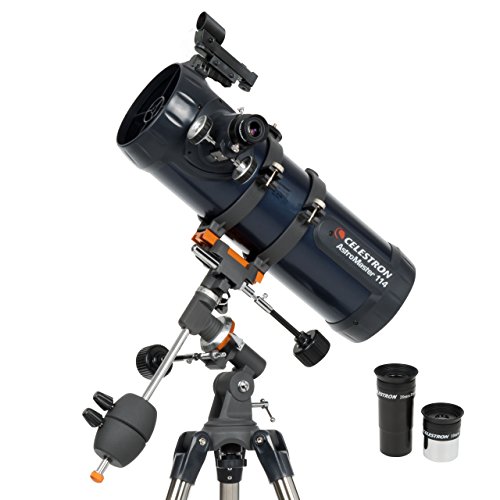
Pros
- Extremely easy and simple to assemble (No tools required)
- Budget friendly price range
- Crystal clear images of over 10,000 celestial objects in database
Cons
- Typical of budget models, plastic parts are very flimsy
Overview
If you’re looking at the 114 EQ, I’m going to guess that you’re either shopping for a simple gift or just beginning your infinite journey to stargazing. Long story short, it’s always wise to start with something affordable that won’t break your bank. The AstroMaster 114 EQ Reflector Telescope is the perfect, budget friendly option.
The scope features erect image optics that are ideal for both astronomical and terrestrial use and a permanently mounted starpointer. Another wining feature is the incorporation of SkyX light edition astronomy software that houses a 10,000 object database for fascinating celestial views. Not bad for a beginner astronomer if you ask me.
What It Does Best
Contrary to popular belief, the affordability of the 114 EQ is not the only feature that makes it stand out in a crowd of astronomers. Nope; what makes it ideal is the fact that this model is super easy to set up and use, even for newbies. This can all be credited to the tool-less assembly, preassembled tripod as well as a quick release dovetail attachment that make work that much easier.
Another area where the AstroMaster Reflector excels is versatility. Not many scopes are great at multitasking, but this one is actually more than appropriate for both terrestrial and celestial viewing. Considering the price range, that’s quite a feat.
Flaws But Not Deal Breakers
As good as the AstroMaster 114 EQ Reflector Telescope sounds, you can always expect a few minor issues with a budget model. One of the most prominent issues I came across was the oversensitivity.
I mean, unless you can maintain a very steady hand (I’m talking surgeon-like), you might find focusing the scope very tough. Even the slightest shift means you have to refocus your target again. Apart from the tricky counterbalancing and some rough declination adjustment, I’d say the 114 EQ is pretty stand up.
What Other Customers Think
Looking at what all the previous customers had to say, it’s pretty obvious that the Celestron 31042 AstroMaster scope is ideal for beginner astronomers, For the price, it offers users quite a decent view.
However, it’s the unbelievably simple, no tools required setup that makes this particular telescope a hit with the kids. So if you want to start your child off on the journey to astronomy, now you know a great and affordable way to do it with the 114 EQ.
Should You Buy It?
What more can I say, the AstroMaster 114 EQ Reflector Telescope speaks for itself. As you’ve no doubt come to see, not many telescopes excel at both celestial and terrestrial viewing. But the fact that the 114 EQ works just as good for earth objects as it does stars is a major feat in itself. And all that at budget friendly prices? If you’re looking to turn even the greenest beginners into well established astro-gazers, then this might just be the only telescope you’ll ever need.
Good Alternatives
- Orion Starblast 6 Astro Reflector Telescope
- Orion StarBlast 4.5 EQ Reflector
- Orion SpaceProbe 130ST Telescope
Frequently Asked Questions
1. What can I see with a 130mm reflector telescope?
A 130mm (5 inch) reflector telescope is relatively small. It’s great for observing the moon and planets, but don’t expect to see sharp details of the moon’s craters or Saturn’s rings. Some planets will appear as pinpoints of light.
A 130mm reflector can also let you see large deep sky objects like certain galaxies, double stars and nebulae. But again, don’t expect the same level of detail you would get from a 6” or 8” telescope.
2. What can I see with a 114mm reflector telescope?
A 114mm (4.5 inch) reflector is fairly small. You can view most objects in the solar system including planets and the moon, but they’ll appear small and you won’t make out fine details. Certain large and bright galaxies, nebulae and star clusters may also be visible especially on a clear night with little to no light pollution.
3. How to set up a reflector telescope
The most important part of setting up a reflector is collimation. Use a collimation cap (usually included with most reflectors) to check and, if necessary, adjust collimation.
Also check that the finderscope is properly aligned with your telescope to make it easy to focus on objects in the sky. Your telescope manual should have instructions on how to align the finderscope.
4. How to clean reflector telescope mirrors
With proper storage, telescope mirrors don’t need cleaning. A bit of dust on them will not affect image quality that much. But if you mirrors are really dusty and cruddy, remove them (carefully!) from the telescope and wash off the dirt under a running faucet. Rinse with distilled water to ensure no watermarks remain.
For stubborn dirt, plug the sink and fill it halfway with lukewarm water. Add some dish soap and slosh the mirror gently in the water. You can use cotton balls to gently wipe away dirt. Rinse with tap water followed by distilled water.
